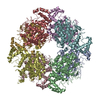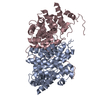[English] 日本語
 Yorodumi
Yorodumi- EMDB-18779: Structure of the non-mitochondrial citrate synthase from Ananas c... -
+ Open data
Open data
- Basic information
Basic information
| Entry |  | ||||||||||||
|---|---|---|---|---|---|---|---|---|---|---|---|---|---|
| Title | Structure of the non-mitochondrial citrate synthase from Ananas comosus | ||||||||||||
 Map data Map data | |||||||||||||
 Sample Sample |
| ||||||||||||
 Keywords Keywords | Complex / TRANSFERASE | ||||||||||||
| Function / homology |  Function and homology information Function and homology informationacyltransferase activity, acyl groups converted into alkyl on transfer / fatty acid beta-oxidation / tricarboxylic acid cycle / peroxisome / carbohydrate metabolic process / mitochondrial matrix Similarity search - Function | ||||||||||||
| Biological species |  | ||||||||||||
| Method | single particle reconstruction / cryo EM / Resolution: 4.15 Å | ||||||||||||
 Authors Authors | Lo YK / Bohn S / Sendker FL / Schuller JM / Hochberg G | ||||||||||||
| Funding support |  Germany, European Union, 3 items Germany, European Union, 3 items
| ||||||||||||
 Citation Citation |  Journal: bioRxiv / Year: 2024 Journal: bioRxiv / Year: 2024Title: Frequent transitions in self-assembly across the evolution of a central metabolic enzyme. Authors: Franziska L Sendker / Tabea Schlotthauer / Christopher-Nils Mais / Yat Kei Lo / Mathias Girbig / Stefan Bohn / Thomas Heimerl / Daniel Schindler / Arielle Weinstein / Brain P Metzger / ...Authors: Franziska L Sendker / Tabea Schlotthauer / Christopher-Nils Mais / Yat Kei Lo / Mathias Girbig / Stefan Bohn / Thomas Heimerl / Daniel Schindler / Arielle Weinstein / Brain P Metzger / Joseph W Thornton / Arvind Pillai / Gert Bange / Jan M Schuller / Georg K A Hochberg /   Abstract: Many enzymes assemble into homomeric protein complexes comprising multiple copies of one protein. Because structural form is usually assumed to follow function in biochemistry, these assemblies are ...Many enzymes assemble into homomeric protein complexes comprising multiple copies of one protein. Because structural form is usually assumed to follow function in biochemistry, these assemblies are thought to evolve because they provide some functional advantage. In many cases, however, no specific advantage is known and, in some cases, quaternary structure varies among orthologs. This has led to the proposition that self-assembly may instead vary neutrally within protein families. The extent of such variation has been difficult to ascertain because quaternary structure has until recently been difficult to measure on large scales. Here, we employ mass photometry, phylogenetics, and structural biology to interrogate the evolution of homo-oligomeric assembly across the entire phylogeny of prokaryotic citrate synthases - an enzyme with a highly conserved function. We discover a menagerie of different assembly types that come and go over the course of evolution, including cases of parallel evolution and reversions from complex to simple assemblies. Functional experiments in vitro and in vivo indicate that evolutionary transitions between different assemblies do not strongly influence enzyme catalysis. Our work suggests that enzymes can wander relatively freely through a large space of possible assemblies and demonstrates the power of characterizing structure-function relationships across entire phylogenies. | ||||||||||||
| History |
|
- Structure visualization
Structure visualization
| Supplemental images |
|---|
- Downloads & links
Downloads & links
-EMDB archive
| Map data |  emd_18779.map.gz emd_18779.map.gz | 28.7 MB |  EMDB map data format EMDB map data format | |
|---|---|---|---|---|
| Header (meta data) |  emd-18779-v30.xml emd-18779-v30.xml emd-18779.xml emd-18779.xml | 16.9 KB 16.9 KB | Display Display |  EMDB header EMDB header |
| Images |  emd_18779.png emd_18779.png | 76 KB | ||
| Filedesc metadata |  emd-18779.cif.gz emd-18779.cif.gz | 6 KB | ||
| Others |  emd_18779_half_map_1.map.gz emd_18779_half_map_1.map.gz emd_18779_half_map_2.map.gz emd_18779_half_map_2.map.gz | 28 MB 28 MB | ||
| Archive directory |  http://ftp.pdbj.org/pub/emdb/structures/EMD-18779 http://ftp.pdbj.org/pub/emdb/structures/EMD-18779 ftp://ftp.pdbj.org/pub/emdb/structures/EMD-18779 ftp://ftp.pdbj.org/pub/emdb/structures/EMD-18779 | HTTPS FTP |
-Validation report
| Summary document |  emd_18779_validation.pdf.gz emd_18779_validation.pdf.gz | 802.4 KB | Display |  EMDB validaton report EMDB validaton report |
|---|---|---|---|---|
| Full document |  emd_18779_full_validation.pdf.gz emd_18779_full_validation.pdf.gz | 802 KB | Display | |
| Data in XML |  emd_18779_validation.xml.gz emd_18779_validation.xml.gz | 10.8 KB | Display | |
| Data in CIF |  emd_18779_validation.cif.gz emd_18779_validation.cif.gz | 12.7 KB | Display | |
| Arichive directory |  https://ftp.pdbj.org/pub/emdb/validation_reports/EMD-18779 https://ftp.pdbj.org/pub/emdb/validation_reports/EMD-18779 ftp://ftp.pdbj.org/pub/emdb/validation_reports/EMD-18779 ftp://ftp.pdbj.org/pub/emdb/validation_reports/EMD-18779 | HTTPS FTP |
-Related structure data
| Related structure data |  8qzpMC  8qwbC M: atomic model generated by this map C: citing same article ( |
|---|---|
| Similar structure data | Similarity search - Function & homology  F&H Search F&H Search |
- Links
Links
| EMDB pages |  EMDB (EBI/PDBe) / EMDB (EBI/PDBe) /  EMDataResource EMDataResource |
|---|---|
| Related items in Molecule of the Month |
- Map
Map
| File |  Download / File: emd_18779.map.gz / Format: CCP4 / Size: 30.5 MB / Type: IMAGE STORED AS FLOATING POINT NUMBER (4 BYTES) Download / File: emd_18779.map.gz / Format: CCP4 / Size: 30.5 MB / Type: IMAGE STORED AS FLOATING POINT NUMBER (4 BYTES) | ||||||||||||||||||||||||||||||||||||
|---|---|---|---|---|---|---|---|---|---|---|---|---|---|---|---|---|---|---|---|---|---|---|---|---|---|---|---|---|---|---|---|---|---|---|---|---|---|
| Projections & slices | Image control
Images are generated by Spider. | ||||||||||||||||||||||||||||||||||||
| Voxel size | X=Y=Z: 1.09 Å | ||||||||||||||||||||||||||||||||||||
| Density |
| ||||||||||||||||||||||||||||||||||||
| Symmetry | Space group: 1 | ||||||||||||||||||||||||||||||||||||
| Details | EMDB XML:
|
-Supplemental data
-Half map: #1
| File | emd_18779_half_map_1.map | ||||||||||||
|---|---|---|---|---|---|---|---|---|---|---|---|---|---|
| Projections & Slices |
| ||||||||||||
| Density Histograms |
-Half map: #2
| File | emd_18779_half_map_2.map | ||||||||||||
|---|---|---|---|---|---|---|---|---|---|---|---|---|---|
| Projections & Slices |
| ||||||||||||
| Density Histograms |
- Sample components
Sample components
-Entire : Octameric complex of non-mitochondrial/glyoxysomal citrate syntha...
| Entire | Name: Octameric complex of non-mitochondrial/glyoxysomal citrate synthase from Ananas comosus |
|---|---|
| Components |
|
-Supramolecule #1: Octameric complex of non-mitochondrial/glyoxysomal citrate syntha...
| Supramolecule | Name: Octameric complex of non-mitochondrial/glyoxysomal citrate synthase from Ananas comosus type: complex / ID: 1 / Parent: 0 / Macromolecule list: all |
|---|---|
| Source (natural) | Organism:  |
-Macromolecule #1: Citrate synthase
| Macromolecule | Name: Citrate synthase / type: protein_or_peptide / ID: 1 / Number of copies: 8 / Enantiomer: LEVO |
|---|---|
| Source (natural) | Organism:  |
| Molecular weight | Theoretical: 57.611801 KDa |
| Recombinant expression | Organism:  |
| Sequence | String: MEGAFDHSAL ARARLAVLSG HLAAVSAAGG GASPLERSPV SVQEIPPPPR NLGGSLAVID GRSGKKFEFK ISDEGTVRAT DFKKITTGK NDKGLKLYDP GYLNTAPVRS SICYIDGDEG ILRYRGYPIE ELAESSSYPE VAYLLMYGNL PSKSQLADWE F AISQHSAV ...String: MEGAFDHSAL ARARLAVLSG HLAAVSAAGG GASPLERSPV SVQEIPPPPR NLGGSLAVID GRSGKKFEFK ISDEGTVRAT DFKKITTGK NDKGLKLYDP GYLNTAPVRS SICYIDGDEG ILRYRGYPIE ELAESSSYPE VAYLLMYGNL PSKSQLADWE F AISQHSAV PQGVLDIIQG MPHDAHPMGV LVCAMSALSV FHPDANPALR GQDLYKSKQL RDKQIVRILG KVPTIAAAAY LR LAGRPPV LPSNNFSYSE NFLYMLDSLG NRSYKPNTRL ARVLDILFIL HAEHEMNCST AAARHLASSG VDVFTALAGA VGA LYGPLH GGANEAVLKM LNEIGTVENI PDFIEGVKNR KRKMSGFGHR VYKNYDPRAK VIRKLAEEVF SIVGRDPLIE VAIA LEKAA LSDEYFIKRK LYPNVDFYSG LIYRAMGFPT EFFPVLFAIP RMAGYLAHWR ESLDDPDTKI MRPQQVYTGV WLRHY TPLQ ERTVSNDEDK LGQVAVSNAT RRRLAGSRIL EHHHHHH UniProtKB: Citrate synthase |
-Experimental details
-Structure determination
| Method | cryo EM |
|---|---|
 Processing Processing | single particle reconstruction |
| Aggregation state | particle |
- Sample preparation
Sample preparation
| Buffer | pH: 7.3 |
|---|---|
| Vitrification | Cryogen name: ETHANE-PROPANE / Chamber humidity: 100 % / Chamber temperature: 277 K |
- Electron microscopy
Electron microscopy
| Microscope | FEI TITAN KRIOS |
|---|---|
| Image recording | Film or detector model: GATAN K3 (6k x 4k) / Average electron dose: 55.0 e/Å2 |
| Electron beam | Acceleration voltage: 300 kV / Electron source:  FIELD EMISSION GUN FIELD EMISSION GUN |
| Electron optics | Illumination mode: FLOOD BEAM / Imaging mode: BRIGHT FIELD / Nominal defocus max: 3.0 µm / Nominal defocus min: 0.5 µm / Nominal magnification: 29000 |
| Experimental equipment |  Model: Titan Krios / Image courtesy: FEI Company |
 Movie
Movie Controller
Controller





 Z (Sec.)
Z (Sec.) Y (Row.)
Y (Row.) X (Col.)
X (Col.)




































